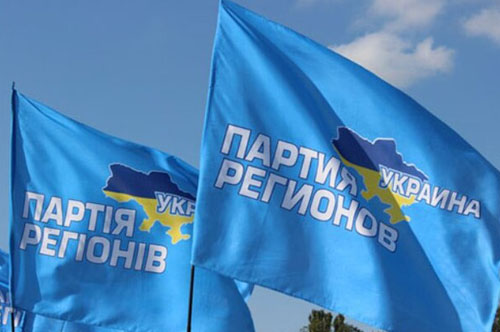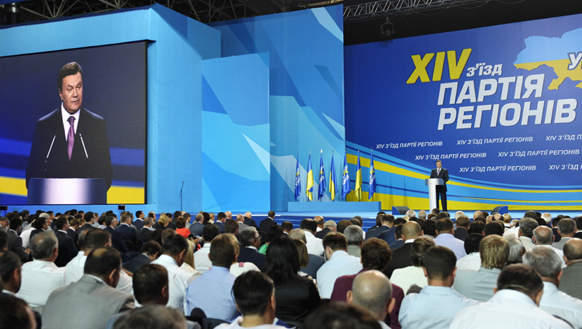Party of Regions
Party of Regions [Партія регіонів; Partiia rehioniv]. One of contemporary Ukraine’s few examples of a highly successful ‘political machine’ type of political party, which flourished and faded under the direction of Viktor Yanukovych. Originating in Donetsk, it advocated the preservation of the industrial and financial interests of Donetsk oblast (and the Donets Basin in general) as well as the protection of its Russian-speaking electorate.
Like many others within the ever-fluid political party system in post-Communist Ukraine, the Part of Regions had its antecedents and successors. Its true forerunner was the Party of Regional Rebirth created in the fall of 1997 by Volodymyr Rybak, a former Communist Party of Ukraine (CPU) apparatchik and Donetsk mayor. The party received less than one per cent of the vote on the Proportional Representation (PR) ballot in December 1997, plus one Single-Member District (SMD) constituency. In 1999, it supported Leonid Kuchma for president.
The Party of Regions itself came into being by combining Rybak’s party with four others: Petro Poroshenko’s Solidarity Party (registered 1997); Leonid Chernovetsky’s For a Beautiful Ukraine (1998); Valentyn Landyk’s Labor Party (1993); and Hennadii Samofalov’s Party of Pensioners (1998). The founding congress was held in November 2000, and the new party registered in March 2001, although the Central Electoral Commission records its registration as having been in 1997. This discrepancy in the dates of its origin suggests that the Party of Regional Rebirth actually incorporated the other four parties gaining a new lease on life. Largely a vehicle for the Donetsk clan, with financial backing from oligarchs such as Dmytro Firtash and Yurii Boiko as well as with links to regional organized crime bosses, initiative for the merger came from the President’s Office of Leonid Kuchma. Mykola Azarov, its initial leader, built this party up to a membership of 460,000, and then stepped aside while Volodymyr Semynozhenko, vice-prime minister of Ukraine, took over the leadership. Semynozhenko brought the Party of Regions into the pro-presidential For a United Ukraine bloc. Poroshenko, meanwhile, defected to join the Our Ukraine camp led by Viktor Yushchenko. Outside of the electoral cycle a Party of Regions caucus within parliament was created numbering 24 deputies.
Following a declaration made in the summer of 2001 to combine with other parties for the forthcoming elections, the Party of Regions joined four others in December 2001 to formalize the creation of the For a United Ukraine electoral alliance. The others were: the Agrarian Party of Ukraine (Mykhailo Hladii), Labor Ukraine (Serhii Tyhypko), Party of Industrialists and Entrepreneurs (Anatolii Kinakh), and People’s Democratic party (Valerii Pustovoitenko).
After the 2002 elections, on 20 June, the For a United Ukraine contingent of 175 deputies in the Supreme Council of Ukraine split up into its various components, with the Party of Regions fraction (caucus) renaming itself Ukraine’s Regions and numbering now 35 parliamentarians. Raisa Bohatyrova became leader of the caucus. Over the course of the next twelve months the caucus grew steadily in size. On 29 January 2003, it contained 42 deputies, and on 29 April 2003, 43 deputies. Ukraine’s Regions remained a consistent supporter of the policies and initiatives of President Leonid Kuchma. In the fall of 2002, when Kuchma was looking to replace Anatolii Kinakh as prime minister, Ukraine’s Regions put forward the successful candidacy of Donetsk oblast governor Viktor Yanukovych.
On 19 April 2003 at a congress in Kyiv, Prime Minister Yanukovych was elected leader of the extraparliamentary Party of Regions (unlike the parliamentary caucus, it retained its original name), succeeding Volodymyr Semynozhenko. Not unexpectedly, the new leader pledged to support wholeheartedly the Kuchma constitutional reforms, including a bicameral legislature and proportional representation electoral system.
When Ukraine’s Regions merged with European Choice (led by Volodymyr Piekhota) in November 2003, it became the second-largest caucus in parliament with 64 deputies. Bohatyrova remained as leader of the combined caucus. In February 2004, Viktor Yanukovych and Larysa Bohatyrova (later expelled from the party) were joined by eleven other party and caucus leaders agreeing to form a pro-government ‘coalition of democratic forces’ to implement Leonid Kuchma’s constitutional changes, to support a common candidate in the 2004 presidential election, and to provide a basis for stable coalition government. At its congress on 4 July 2004, the party formally proposed Yanukovych as presidential candidate. As of 13 July 2004, its parliamentary caucus still comprised 63 deputies.
Following the Orange Revolution and Viktor Yanukovych’s loss in the presidential elections to Viktor Yushchenko, the Party of Regions under the leadership of Yanukovych won a plurality of 32.1 per cent of the vote in the 2006 elections to the Supreme Council of Ukraine. This gave the party 186 seats. Together with the Socialist Party of Ukraine and Communist Party of Ukraine they comprised a majority and secured for Yanukovych a return to the post of prime minister. Thus despite the return of the Yanukovych-Yushchenko rivalry, the Party of Regions could now reward its supporters with rent-seeking opportunities, protection, and favours in line with the ‘machine politics’ model. It became a refuge for all manner of anti-Orange inclinations—populist, oligarchic, and pro-Russian. In this way it was able to coopt other parties including the CPU and its voter base.
In 2007, the Party of Regions campaigned on a program of ‘Stability and Prosperity.’ In addition to giving the Russian language the status of a state language (on par with Ukrainian), it promised social guarantees, better health care, help for farmers and family businesses, greater opportunities for higher education, systematic reforms, and a referendum on accession to NATO. It would attempt to maintain a neutral and balanced stance for Ukraine in international affairs. Much of this appealed principally to voters still not reconciled to the collapse of the Soviet Union and its socioeconomic order. Its vote improved to 34.4 percent, although in absolute numbers it slipped from 8.1 to 8.0 million. In Donetsk oblast, the vote was 72.1 per cent; only 3 percent in Ivano-Frankivsk oblast. This illustrated the party’s polarizing effect on the electorate. Despite the increased vote share, the Party of Regions obtained 175 seats in the Supreme Council of Ukraine, a loss of 11. Its legislative record embodied very little of the party’s electoral platform, except for a modest effort to better the lives of rural residents.
The party nominated Viktor Yanukovych as presidential candidate in 2009. Elected president in 2010, he surrendered the party chairmanship to Mykola Azarov but remained its real leader. Under him, the Party of Regions with support of the CPU and the Volodymyr Lytvyn bloc as well as individual defectors from other parties amended the house regulations so that individual deputies (MPs) could join the governing coalition instead of a coalition comprising only entire fractions (caucuses). This created a pro-presidential majority and made possible the functioning of the Supreme Council as a ‘rubber stamp’ parliament. Local elections were managed so as to assure Party of Regions dominance in a plurality of oblasts and raions throughout the country. The party’s reform program went largely unfulfilled while its energies were concentrated on the essentials of ‘machine politics’—cooption of potential rivals, rewarding supporters, and garnering votes.
In the 2012 elections to the Supreme Council of Ukraine, having ingested Serhii Tyhypko’s Strong Ukraine party, the Party of Regions’ share of the vote at 6.1 million was still the largest, but had fallen to 30 percent. It earned 72 seats through the PR ballot, and added 113 in SMDs where its ‘political machine’ style of corralling voters paid off handsomely. Its total number of seats therefore rose by 10 to 185. By contrast, Yuliia Tymoshenko’s Batkivshchyna electoral alliance, in second place with 5.2 million, won 25.6 per cent for 62 PR seats, plus only 39 in SMDs, for a total of 101. The Communist Party of Ukraine, with no state resources to distribute, gained 13.2 per cent of the vote for 32 seats and none at all in SMDs, these having been taken by the Party of Regions with its populist promises and ‘machine’ tactics. In the campaign, the Party of Regions claimed in its billboard advertising to have achieved the earlier promised ‘stability.’
Following President Viktor Yanukovych’s flight from office and country in the wake of the Euromaidan Revolution in February 2014, the Party of Regions actually joined in his condemnation but unsurprisingly also began to disintegrate. By September its parliamentary caucus was down to 77 members, from 207 in June 2013. In the presidential election in May 2014, its candidate, Mykhailo Dobkin, obtained only 3 per cent of the vote. In October, the party decided not to participate in the pre-term parliamentary elections, but a number of its notables formed a new party, the Opposition Bloc.
Impacted by public revelations about the corruption, kleptocracy, vanity, and violence associated with Viktor Yanukovych, the Opposition Bloc took only 9.4 per cent of the vote in the parliamentary elections of 2014, securing fourth place. Even in Donetsk oblast its percentage of the vote by comparison with the Party of Regions’ standard was halved—to 38.7 percent. In August 2017, Vadym Rabinovych deserted the Party of Regions to form a new party, Za zhyttia (For Life); then together with some of Dmytro Firtash’s clients who had been expelled from the Party of Regions, they formed yet another new party, Opposition Platform—For Life. In the 2019 elections to the Supreme Council of Ukraine, Opposition Platform—For Life earned 13.1 per cent of the vote for 37 seats; altogether including SMD victories it became the second-largest caucus with a total of 44 deputies. No longer a ‘political machine,’ this grandchild of the Party of Regions represented a pro-Russian, anti-market tendency, a remnant of the Soviet era. Its parent—the Opposition Bloc—ran separately but, having outlived its usefulness and lost its patron, managed a mere 3.0 per cent of the vote falling below the five per cent threshold and failing to win any seats.
When President Volodymyr Zelensky acted in 2021 to curb the pro-Russian propaganda activity of two of its leaders, businessmen Viktor Medvedchuk and Taras Kozak, the Opposition Platform—For Life resolved to impeach the president. Following the invasion of February 2022, it and 15 other pro-Russian parties were banned, by which time at least ten members of its own fraction in the Supreme Council had fled abroad. The leftovers—two dozen deputies—renamed themselves as Platform for Life and Peace under Yurii Boyko’s leadership. In February 2023, a court upheld the ban on the Party of Regions drawing a line under the story.
BIBLIOGRAPHY
Zimmer, Kerstin. ‘The Comparative Failure of Machine Politics, Administrative Resources and Fraud,’ Canadian Slavonic Papers, 47, nos. 3-4 (September-December 2005)
Haran, Oleksii. ‘From Viktor to Viktor: Democracy and Authoritarianism in Ukraine,’ Demokratizatsiya, 19, no. 2 (Spring 2011)
———. ‘Ukraine: Pluralism by Default, Revolution, Thermidor,’ Russian Politics and Law, 50, no. 4 (July-August 2012)
Kudelia, Serhiy; Kuzio, Taras. ‘Nothing Personal: Explaining the Rise and Decline of Political Machines in Ukraine,’ Post-Soviet Affairs (2014)
Kuzio, Taras. ‘Crime, Politics and Business in 1990s Ukraine,’ Communist and Post-Communist Studies, 47, no. 2 (June 2014)
Kudelia, Serhiy. ‘The House that Yanukovych Built,’ Journal of Democracy, 25, no. 3 (July 2014)
Kuzio, Taras. ‘Rise and Fall of the Party of Regions Political Machine,’ Problems of Post-Communism, 62 (2015)
Matsuzato, Kimitaka. ‘The Donbass War: Outbreak and Deadlock,’ Demokratizatsiya, 25, no. 2 (Spring 2017)
Ogushi, Atsushi. ‘The Opposition Bloc in Ukraine: A Clientelistic Party with Diminished Administrative Resources,’ Europe-Asia Studies, 72, no. 10 (December 2020)
Bohdan Harasymiw
[This article was written in 2023.]


